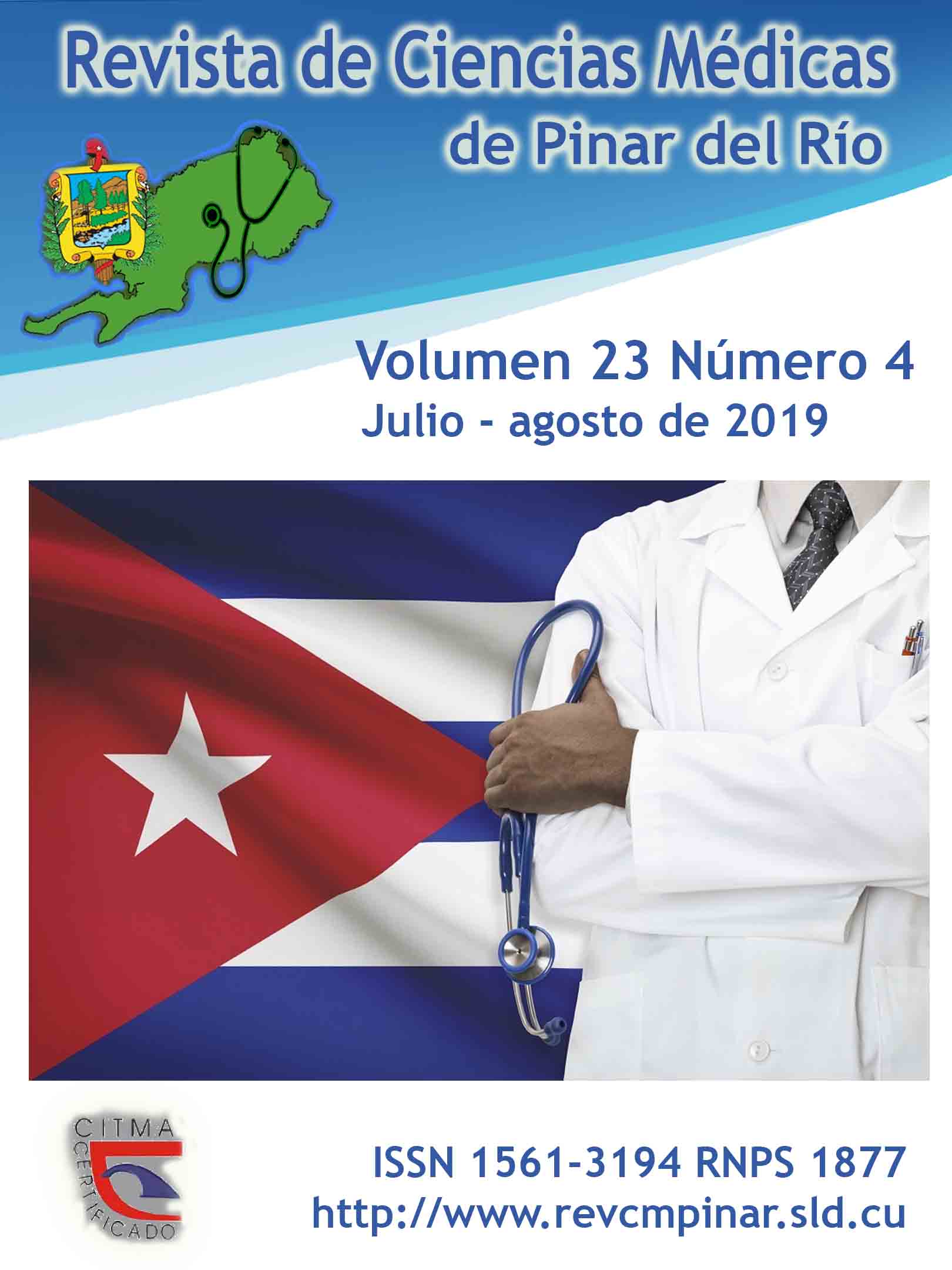University-community contribution in the quality of life of the elderly
Keywords:
COMMUNITY PARTICIPATION, AGED, QUALITY OF LIFE, COMPREHENSIVE HEALTH CARE, MENTAL HEALTH.Abstract
Introduction: the community and the university have a direct, bilateral and indissoluble relationship associated with the historical-social development of nations, and within the current problems of society, aging of the population is one of them.
Objective: to show the results of the university-community contribution in the quality of life of the elderly, from 2016 to 2018 in Los Palacios municipality.
Methods: qualitative-quantitative research with a first descriptive-evaluative part and interventions of the university in the community, and a second part, evaluation of results. The target group was comprised of 41 doctors’ offices of the territory and a population of old adults of 7 847 people. The SWOT matrix (strengths, weaknesses, opportunities, and threats), was applied and problems were prioritized applying the ranking method.
Results: the participation of the teaching staff and old adults who were residents in three Chairs of seniors and underwent in periodic health examinations were achieved at 113 %, training and diploma courses were taught, related to the elderly. A 6 % reduction in mortality rate was general achieved in old adults and in four of the five diseases traced and treated in the Intensive Municipal Area; the community projection in the 22 medical specialties that included the teaching of educational activities given by the Basic Health Teams.
Conclusions: the university-community contribution in Los Palacios has developed a participative culture and style that involves the integrated action of social actors, in a promotional attitude for the improvement of the quality of life of the elderly.
Downloads
References
1. Saldaña Campos L. La Universidad como institución pertinente en el avance de la sociedad. Educación Médica Superior [Internet]. 2017 [citado 17/05/2018]; 31(3): [aprox. 0 p.]. Disponible en: http://www.ems.sld.cu/index.php/ems/article/view/630
2. Vega García E y otros. Atención al adulto mayor. En: Álvarez Sintes R. Medicina General Integral. Vol. 2. 3raed. La Habana: Editorial Ciencias Médicas; 2014.
3. Castro Rodríguez A, Orozco Hernández JP, Medina DM. Polifarmacia y prescripcion de medicamentos potencialmente no apropiados en ancianos. RevMed Risaralda [Internet]. 2016 [citado 19/06/2017]; 22(1): [aprox. 5p.]. Disponible en: http://www.scielo.org.co/pdf/rmri/v21n2/v21n2a11.pdf.
4. Grupo promotor red local para la salud comunitaria. Guía metodológica para el abordaje de la salud desde una perspectiva comunitaria. [internet] Ozaquidetza, gobierno Vazco; 2016. [citado 28/03/2018]. Disponible en: http://www.euskadi.eus/contenidos/informacion/salud_comunitaria/es_def/adjuntos/guia-metodologia-esp.pdf
5. Pérez Díaz A. El desarrollo de las formas de organización político administrativas en Cuba: Apuntes sobre el trabajo social comunitario en el contexto urbano. Trabajo social hoy [Internet] 2014 [citado 28/03/2018]; 72: [aprox. 30p.]. Disponible en: https://dialnet.unirioja.es/servlet/articulo?codigo=5260364
6. Rodríguez Quintana T, Fabelo Roche JR, Iglesias Moré S, Gavilanes Cueva YP. Vinculación de la universidad y la comunidad para contribuir a mejorar la atención de los adultos mayores. Rev Edu Med Sup [Internet]. 2018 [citado 25/02/2019]; 32(2). Disponible en: http://ems.sld.cu/index.php/ems/article/view/1387
7. Vialart Vidal MN, Rodríguez López EI, Véliz Martínez PL, Suárez Cabrera A, Morales Cordovés E, Zelada Pérez Md, et al. Tendencias actuales de programas de estudio de pregrado y posgrado con orientación a la Atención Primaria de la Salud. Educación Médica Superior [Internet]. 2016 [citado 17/05/2017]; 30(3): [aprox. 0 p.]. Disponible en: http://www.ems.sld.cu/index.php/ems/article/view/839
8. Pla-García A, Nieves-Sardiñas B, Barreto-Landa D. Comportamiento del Programa de Medicina Familiar en el Municipio Jovellanos. 2013. Revista Médica Electrónica [Internet]. 2014 [citado 18/05/2017]; 36(6): [aprox. 9p.]. Disponible en: http://www.revmedicaelectronica.sld.cu/index.php/rme/article/view/1138.
9. Veliz Martínez Pedro L. Áreas Intensivas Municipales. Rev Cub de Med Int Emerg [Internet]. 2014 [Citado 23/03/2018]; 13(1): [aprox. 1p.]. Disponible en: http://www.revmie.sld.cu/index.php/mie/article/view/24/45.
10. Valdés Suárez O. Morbimortalidad del área intensiva municipal de güira de melena. Ocho años de trabajo. Rev Cub de Med Int Emerg [Internet]. 2014 [Citado 23/03/2018]; 13(1): [aprox. 9p.]. Disponible en: http://www.revmie.sld.cu/index.php/mie/article/view/7.
11. Gort Hernández M, Martínez García RA, Valdés Cardentey D. Comportamiento de los principales indicadores funcionales del área intensiva municipal de Los Palacios. Rev Ciencias Médicas [Internet]. 2018 [citado 06/03/2019]; 22(4): [aprox. 7p.]. Disponible en: www.revcmpinar.sld.cu/index.php/publicaciones/article/view/3572
Published
How to Cite
Issue
Section
License
Authors who have publications with this journal agree to the following terms: Authors will retain their copyrights and grant the journal the right of first publication of their work, which will be publication of their work, which will be simultaneously subject to the Creative Commons Attribution License (CC-BY-NC 4.0) that allows third parties to share the work as long as its author and first publication in this journal are indicated.
Authors may adopt other non-exclusive license agreements for distribution of the published version of the work (e.g.: deposit it in an institutional telematic archive or publish it in a volume). Likewise, and according to the recommendations of the Medical Sciences Editorial (ECIMED), authors must declare in each article their contribution according to the CRediT taxonomy (contributor roles). This taxonomy includes 14 roles, which can be used to represent the tasks typically performed by contributors in scientific academic production. It should be consulted in monograph) whenever initial publication in this journal is indicated. Authors are allowed and encouraged to disseminate their work through the Internet (e.g., in institutional telematic archives or on their web page) before and during the submission process, which may produce interesting exchanges and increase citations of the published work. (See The effect of open access). https://casrai.org/credit/



